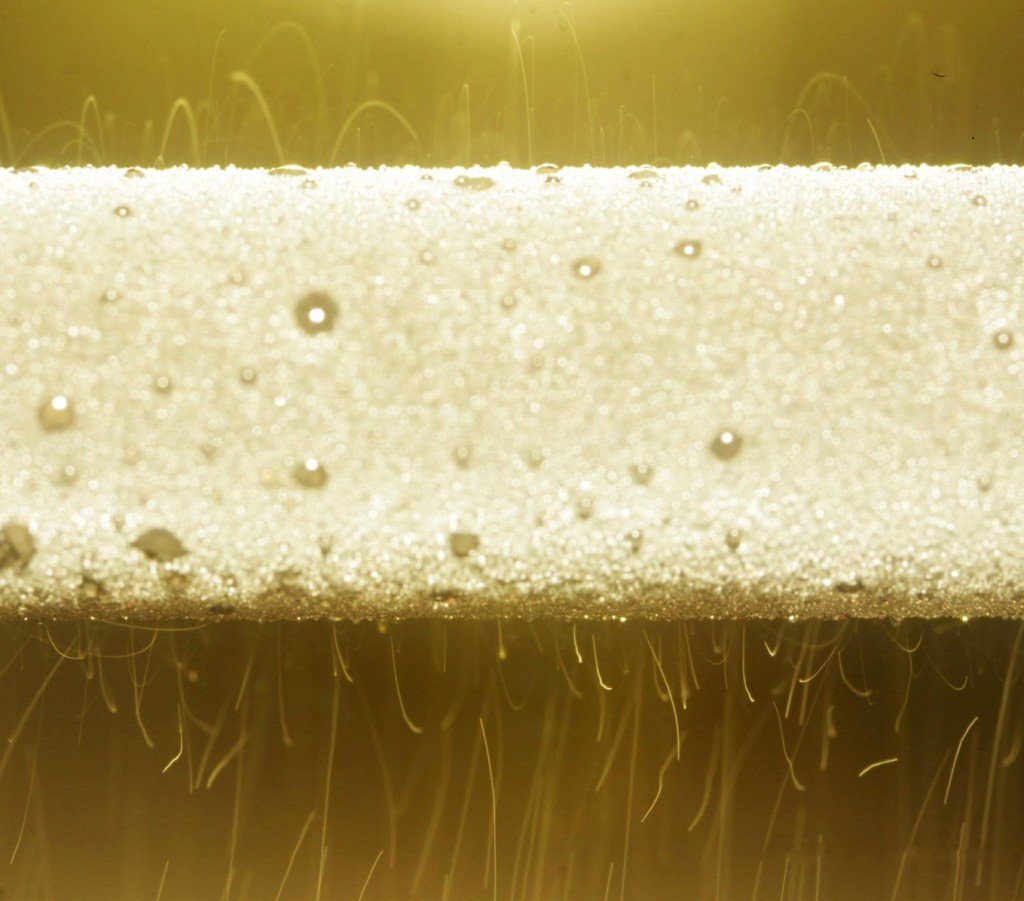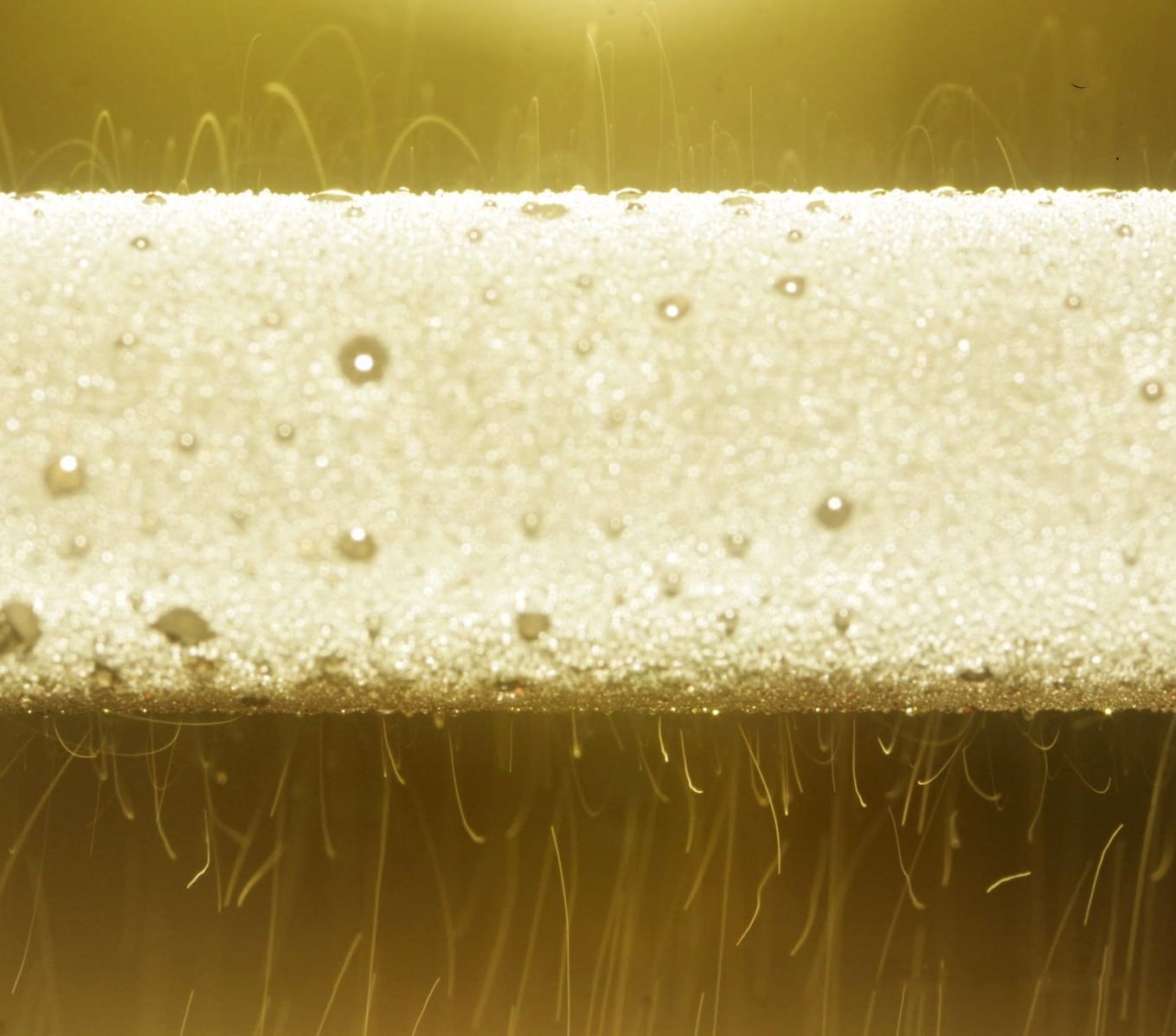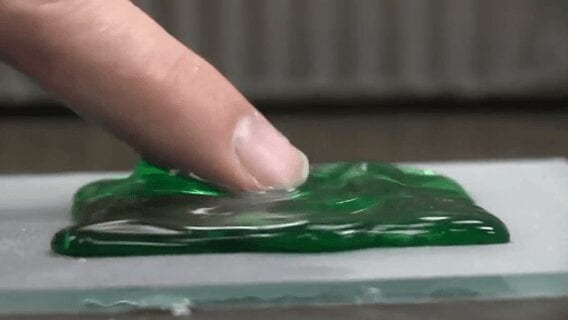
Condensation on a metal plate leads to formation of droplets that carry electric charge, could improve power-plant efficiency.
In a completely unexpected finding, MIT researchers have discovered that tiny water droplets that form on a superhydrophobic surface, and then “jump” away from that surface, carry an electric charge. The finding could lead to more efficient power plants and a new way of drawing power from the atmosphere, they say.
The finding is reported in a paper in the journal Nature Communications written by MIT postdoc Nenad Miljkovic, mechanical engineering professor Evelyn Wang, and two others.
Miljkovic says this was an extension of previous work by the MIT team. That work showed that under certain conditions, rather than simply sliding down and separating from a surface due to gravity, droplets can actually leap away from it. This occurs when droplets of water condense onto a metal surface with a specific kind of superhydrophobic coating and at least two of the droplets coalesce: They can then spontaneously jump from the surface, as a result of a release of excess surface energy.
In the new work, “We found that when these droplets jump, through analysis of high-speed video, we saw that they repel one another midflight,” Miljkovic says. “Previous studies have shown no such effect. When we first saw that, we were intrigued.”
In order to understand the reason for the repulsion between jumping droplets after they leave the surface, the researchers performed a series of experiments using a charged electrode. Sure enough, when the electrode had a positive charge, droplets were repelled by it as well as by each other; when it had a negative charge, the droplets were drawn toward it. This established that the effect was caused by a net positive electrical charge forming on the droplets as they jumped away from the surface.
The charging process takes place because as droplets form on a surface, Miljkovic says, they naturally form an electric double layer — a layer of paired positive and negative charges — on their surfaces. When neighboring drops coalesce, which leads to their jumping from the surface, that process happens “so fast that the charge separates,” he says. “It leaves a bit of charge on the droplet, and the rest on the surface.”
The initial finding that droplets could jump from a condenser surface — a component at the heart of most of the world’s electricity-generating power plants — provided a mechanism for enhancing the efficiency of heat transfer on those condensers, and thus improving power plants’ overall efficiency. The new finding now provides a way of enhancing that efficiency even more: By applying the appropriate charge to a nearby metal plate, jumping droplets can be pulled away from the surface, reducing the likelihood of their being pushed back onto the condenser either by gravity or by the drag created by the flow of the surrounding vapor toward the surface, Miljkovic says.
“Now we can use an external electric field to mitigate” any tendency of the droplets to return to the condenser, “and enhance the heat transfer,” he says.
But the finding also suggests another possible new application, Miljkovic says: By placing two parallel metal plates out in the open, with “one surface that has droplets jumping, and another that collects them … you could generate some power” just from condensation from the ambient air. All that would be needed is a way of keeping the condenser surface cool, such as water from a nearby lake or river. “You just need a cold surface in a moist environment,” he says. “We’re working on demonstrating this concept.”
The Latest Bing News on:
Superhydrophobic
- I'd Never Guess These Well-Made, '90s-Esque Sunglasses Cost Less Than $60on May 7, 2024 at 7:00 am
I've remained devoted to the same pair of Le Specs sunglasses for years. (I own them in three colorways.) But I've been prepping for my spring and summer travels, and I got the itch to expand my ...
- Materials Science Newson May 6, 2024 at 4:59 pm
May 7, 2024 — Researchers reveal a new pathway for designing optical materials using the degree of atomic disorder. The researchers anticipate developing crystals that enable advanced infrared ...
- Mother’s Day gift guide: 35 fabulous gifts for golf-loving momson May 6, 2024 at 5:07 am
Shop our selection of curated gifts to shower your golf-loving Mom with the love and appreciation she deserves this Mother's Day.
- Biochemistry Newson May 3, 2024 at 5:01 pm
May 2, 2024 — Researchers have developed a unique shape-tunable mirror that can change shape to optimally channel X-rays. It is composed of a single crystal of lithium niobate. This new ...
- Best women's golf shoes for Mother's Day 2024on April 30, 2024 at 8:00 am
The Asics Gel-Kayano Ace 2 Spikeless golf shoe is one of the most comfortable shoes on the market. The Gel-Kayano has lightweight ankle padding, directional jacquard mesh, waterproof upper, TPU heel ...
- Accidental Discovery Transforms Cork Into an Eco-Friendly Oil Spongeon April 23, 2024 at 8:50 am
Treated cork has higher absorbance, harnesses sunlight to trap oil in minutes. Oil spills are deadly disasters for ocean ecosystems. They can have lasting impacts on fish and marine mammals for ...
- Laser-treated cork absorbs oil for carbon-neutral ocean cleanupon April 22, 2024 at 4:59 pm
"In a different laser experiment, we accidentally found that the wettability of the cork processed using a laser changed significantly, gaining superhydrophobic (water-repelling) and ...
- Physicists explain, and eliminate, unknown force dragging against water droplets on superhydrophobic surfaceson April 16, 2024 at 7:37 am
Air-shearing effect Creating better superhydrophobic surfaces would make the world's transportation systems more aerodynamic, medical devices more sterile, and generally improve the slipperiness ...
- Physicists explain, and eliminate, unknown force dragging against water droplets on superhydrophobic surfaceson April 15, 2024 at 5:00 pm
Black silicon is a superhydrophobic material, meaning it repels water. Due to water's unique surface tension properties, droplets glide across textured materials like black silicon by riding on a ...
- Maren Buckon October 3, 2023 at 5:29 pm
Maren Buck is interested in organic and polymer chemistry and the assembly of macromolecular materials useful for applications in medicine. Her lab is currently working on two primary projects. The ...
The Latest Google Headlines on:
Superhydrophobic
[google_news title=”” keyword=”Superhydrophobic” num_posts=”10″ blurb_length=”0″ show_thumb=”left”]
The Latest Bing News on:
Superhydrophobic coating
- I'd Never Guess These Well-Made, '90s-Esque Sunglasses Cost Less Than $60on May 7, 2024 at 7:00 am
I've remained devoted to the same pair of Le Specs sunglasses for years. (I own them in three colorways.) But I've been prepping for my spring and summer travels, and I got the itch to expand my ...
- Physicists explain, and eliminate, unknown force dragging against water droplets on superhydrophobic surfaceson April 15, 2024 at 5:00 pm
Black silicon is a superhydrophobic material, meaning it repels water. Due to water's unique surface tension properties, droplets glide across textured materials like black silicon by riding on a ...
- Superhydrophobicity: Nature-Inspired Water Repellencyon March 20, 2024 at 3:15 am
The long-term durability and mechanical stability of superhydrophobic coatings under harsh environmental conditions remain a concern. Additionally, the scalability and cost-effectiveness of ...
- It is alive! Could a reanimated spider change how we think about robotics?on November 11, 2023 at 6:44 am
The icky inspires Anoop Rajappan. Squishy dead spiders; leaves floating on a sticky marsh; the slimy insides of bhindi. The natural design and chemistry observable in each of these hold clues that ...
- Dip-coatingon October 1, 2021 at 6:16 am
Dip coating is an industrial coating process which is used, for example, to manufacture bulk products such as coated fabrics and condoms and specialised coatings for example in the biomedical field.
- Nonstick Coatings Informationon February 11, 2018 at 7:07 am
Oils and fats may still wet out and adhere to a hydrophobic surface. Coatings or surfaces with a contact angle of 150° or higher are considered superhydrophobic and coatings with a 180° contact angle ...
- Industrial Coatings Informationon February 8, 2018 at 2:20 pm
Industrial coatings are thin films deposited on materials to add or enhance specific properties such as corrosion resistance, wear resistance, conductivity, etc. Industrial coatings are used in ...
- OSCII Activity B.11on November 5, 2016 at 10:56 pm
The addition of a superhydrophobic coating on the nets will provide added protection against scab and insects. To our knowledge, this project is the first in Canada, if not in the world, in which an ...
- A Fountain Of Superhydrophobic Arton June 24, 2016 at 7:56 pm
Superhydrophobic coating finds a new application in art through [Arthur Carabott] in the form of a bizarre fountain. A Master’s student in the Global Innovation Design course at the London Royal ...
- DIY Powder Coatingon October 25, 2015 at 6:14 am
If you don’t yet have a toaster oven you can’t use with food, here’s yet another reason: DIY powder coating. Powder coating is much harder and more durable than paint – a property imbued ...
The Latest Google Headlines on:
Superhydrophobic coating
[google_news title=”” keyword=”superhydrophobic coating” num_posts=”10″ blurb_length=”0″ show_thumb=”left”]











